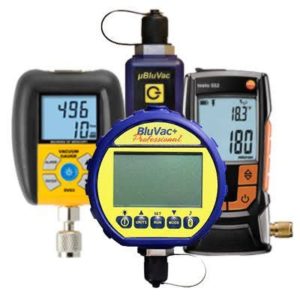A digital vacuum gauge is an essential tool for every HVAC/R technician. It has the capability of measuring the closed system at each evacuation process and confirming that the system is sealed.
While some micron vacuum gauges can read the atmosphere from 1 micron up to 760,000 microns with 5-10 micron resolution, nowadays most professionals need a higher resolution than most full range micron gauges offer. Newer models have technology advancements that allow for portable devices for field technicians and system installers.
A quality AC/R digital micron vacuum gauge starts measuring the evacuation process from 25,000 microns. Allowing the HVAC/R technician to see what is going on in the system and if the system is evacuating correctly or if any issues need to be resolved. It’s highly likely that if you can’t create and hold a vacuum of 25,000 microns you have a serious leak in your set up.
Visualizing Measurement
With cellphones and tables, you can use Bluetooth features to see more than just the microns, features available include leak rates, ambient temperature, saturation temperature, pressure and rise time. These will give you additional insights into the system and what is happening that can save time and expensive callbacks.

Accuracy
A system evacuation entails a lot of things being connected at the same time. Therefore, you should always vacuum down your hoses first, then your manifold, and then confirm you have no leaks before opening the connection to the system. Analogue gauges while rare are attributed to low accuracy and low resolutions for many years and are not designed to be transported in the field.
That is why digital vacuum gauges are recommended for accurate resolution. Most digital vacuum gauges come with 1-micron average resolution for any reading below 12,000 microns.
Accuracy refers to what’s being recorded against the actual happening. The accuracy of a digital vacuum gauge is determined by the manufacturer on their specifications. Repeatability in measurement and reliability is essential in any evacuation task.
Calibration
One method to ensure your vacuum gauge is reading correctly is to connect it directly to your vacuum pump and run your vacuum pump with brand new oil. You should be able to see the gauge read in most cases 15 to50 microns depending on the vacuum pump specifications. Not all vacuum gauges can be easily calibrated, and some models require replacement of the expensive sensors regularly. It’s important to research these factors when first buying your vacuum gauge.
The Easy Solution
The AccuToolsBluVac Vacuum Gauge range has 1 microns resolution for anything below 12000 microns and the BluVac Pro offers superior 0.1 Micron resolution. This makes it reliable when handling different evacuation tasks. With such a resolution, you will easily get accurate results on what is happening to your system at any time.
The BluVacrange is unique as it is the only vacuum gauge that includes both a self-calibration test and the ability to calibrate the device at home. They also include an indicator
Gauge Placement
A deep vacuum should be attained on an entire system for it to be completely dehydrated. The vacuum does not equalize at all system’s point quickly. Therefore, place a vacuum gauge at any access point that is far from the vacuum pump. This is one of the different ways of attaining accurate reading on the entire system.
There are several options, but since we are trying to measure the vacuum of the entire system, we are evacuating then we should connect directly or as close to the system as possible.
The first option is using a core removal tool which will have a ball valve and an option to remove the service valve which will improve our evacuation times and allow us to test our hoses before starting the process.
Another option is to connect to the unused service valve, but only if your vacuum gauge includes a coupler that has a core depressor. A mistake made far too often is not using the correct end of the coupler so make sure you have the coupler facing the right way.
Results will always vary if the vacuum gauge is connected to hoses which can air off or to manifolds. And vacuum readings from gauges directly connected to the vacuum pump will always be a true measurement of the reading at the vacuum pump not of the AC system.
Connecting the vacuum gauge to your vacuum pump or your manifold set will only give you an accurate reading of where it is connected. Not of your HVAC/R System. So the vacuum pump will always show a lower micron reading than the AC system.
